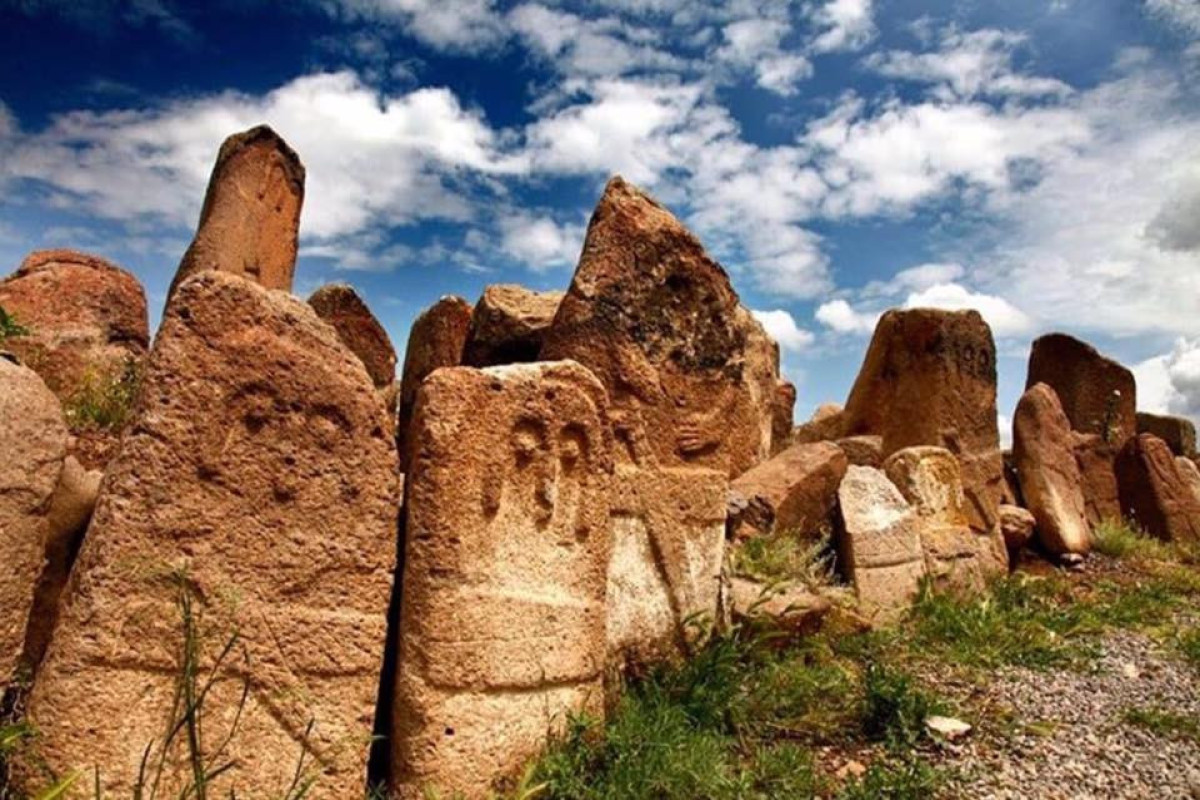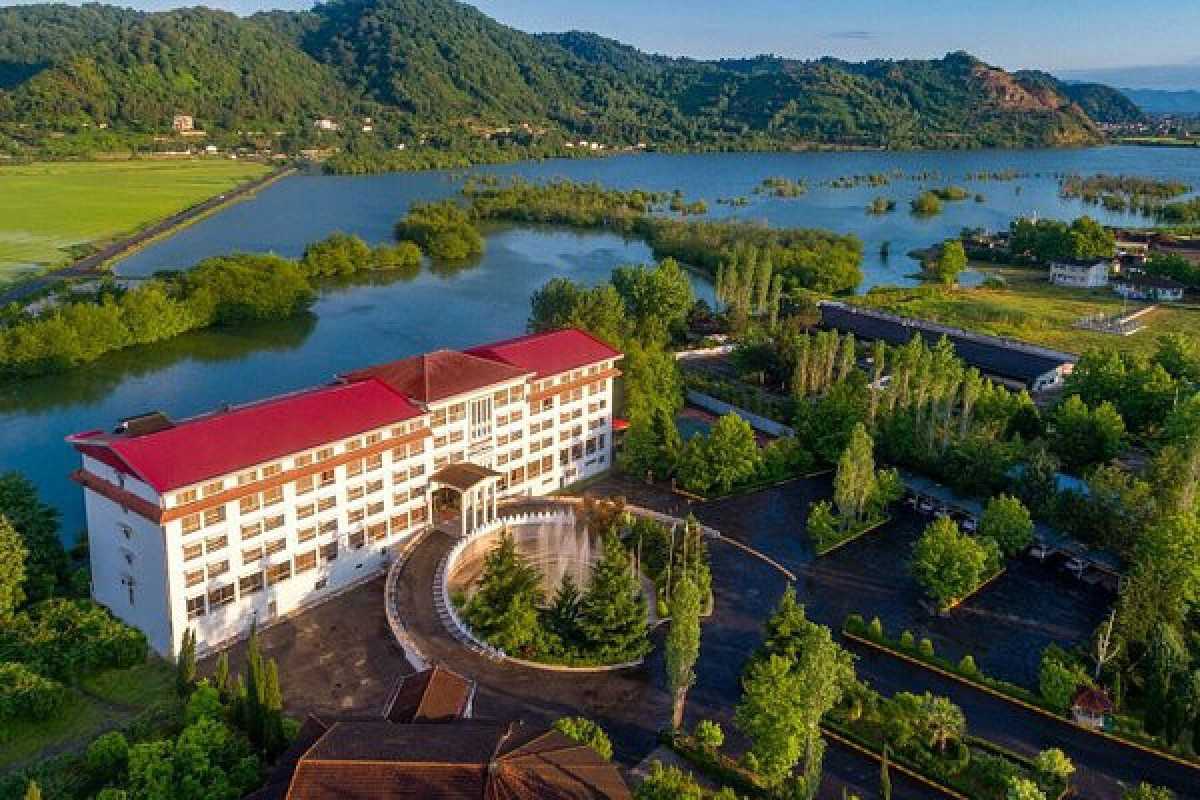Within the framework of the project "Know South Azerbaijan", APA presents the article by Mohammad Rahmanifar entitled "Urban location: a place of plundered history of Azerbaijan".
Khoy city: An impregnable fortress of Azerbaijanism and freedom trench
URMIA: Beating heart of Azerbaijanism
How does the Tehran regime Persianize Turkish toponyms in South Azerbaijan?
Azerbaijani saz wrapped in an American flag and thrown into a fire in Tabriz
If we say that Azerbaijan is the cradle of human civilization with its ancient history, we will not be exaggerating. Numerous historical monuments in different parts of Azerbaijan indicate the settlement of people in this region and the formation of urban and rural culture thousands of years ago. One of the rare works that contains valuable information about the ancient civilization of Azerbaijan is the Shaheryeri complex in South Azerbaijan. In this short article, we will briefly get acquainted with this valuable historical complex and talk about the current state of this collection and the neglect of the Iranian government to preserve it.
Geographical location of the city
Sheheryeri is located near Arja village of Meshkinshaher (Khiyav), one of the cities of Ardabil province of South Azerbaijan. The ancient historical region called Shaheryeri is located 65 km from Ardabil, 31 km east of Meshkinshaher, on the bank of the Garasu river. The ancient Sheheryeri area with an area of more than 400 hectares is located on a stone bed 1.5 km east of Pirazmiyan village of Meshkinshaher. The Karasu river separates it from the surrounding lands in the north and east, and at the same time, it has provided an extraordinary position for it as an element of natural defense. The Karasu River is the largest river in the region and, in fact, the most important natural feature of the Meshkinshaher plain, which played a very important role in the formation of prehistoric and historical settlements in this region and created the necessary conditions and opportunities for its construction. This river surrounds the ancient fortress in the city on three sides.
As we can see, the creators of this huge complex built a wall on only one side of this complex that is not surrounded by the river.
Ancient history of the Sheheryeri
This historical complex consists of three parts: the military fort, the temple and the Double Hill. The castle and temple date back to 1450 BC, and Gosha Tepe to 7000 BC. Some experts estimate the age of this region to be 11,000 years old. More than 500 menhirs, varying in height from 35 to 230 cm, shaped like rectangular cubes or cones, similar to human stelae, are suspended in the walls made of stone chips and mud. In some cases, a flat stone was placed in front of his feet as a pedestal for gifts. The patterns of people carved on the stones are people with their hands on their chests, usually people without mouths, and only 2-mouthed (the mouth is simply drawn with two thin lines) carved figures are found. One of the most important distinguishing features of stelae is whether or not they are armed. On the other hand, there are also differences in the shape of the weapon.
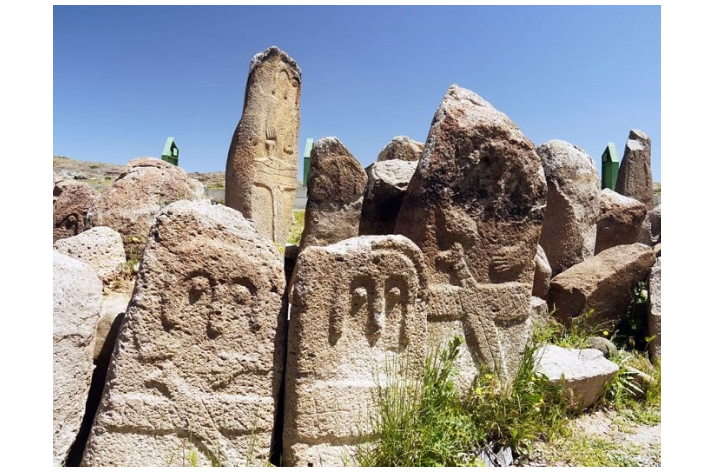
In general, the menhirs found in this region have many similarities with the examples of menhirs found in the Garadagh region of South Azerbaijan, as well as in the Aghdam and Gobustan regions of North Azerbaijan. The menhirs found in North and South Azerbaijan are very similar in appearance as if all the motifs were carved in the same style and design by the same sculptor at the same time. However, based on the determination of the age of similar samples in the Republic of Azerbaijan, their age was between 4,000 and 8,000 years. This fact doubles the miraculous mystery of these works. It is seen that the examples in Shaheryeri and Gobustan were carved based on a specific philosophy of faith. The most commonly engraved motif is the mountain goat, as the mountain goat is an angelic symbol and is derived from ancient mythology. (In the article we wrote about Nowruz holiday ceremonies in South Azerbaijan, we talked about Takmechilik. The goat (goat), which brings the warmth of the coming of summer, is considered a source of inspiration for Tekkems.
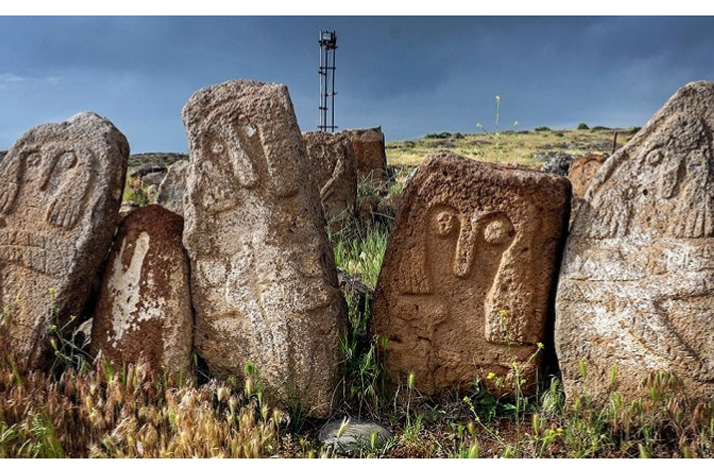
As it can be seen, the importance of menhirs found in the city and in places like Gobustan and Aghdam not only proves the history of Azerbaijan on both sides of the Araz river, but also shows the existence of a common culture on both sides of this border river thousands of years ago. A large number of obsidian stones were discovered in the Shahreri region, which can be a proof of the connection of this region with the Caucasus and Anatolia, because we know that this type of stone was produced in these regions. Obsidian was used to cut hard stones during the Chalcolithic period. Several historical periods related to the Copper (Chalcolithic) Age, Iron Age I and Iron Age II have been identified in the city.
The city was also inhabited in later times, and artifacts from the Urartian period were also found here. During the Urartian period, the castle was burned and abandoned. The presence of ash in the soil layers of the castle indicates the fire of the castle. However, life in this city did not end, because traces of the subsequent historical periods, even the Islamic period, have been found.
The last state of the Sheheryeri
Undoubtedly, restoration, maintenance, preservation, and protection of historic places is the duty of the state. The Iranian government is well aware of this task, as experience shows that the Iranian government pays great attention to the preservation of historical sites and monuments in the regions inhabited by Persians. However, it seems that taking care of the ancient and historical monuments and places located in South Azerbaijan is not one of the duties of the Iranian government. Almost nowhere in South Azerbaijan will you find a historical monument that the Iranian government takes care of and protects as it does in the regions inhabited by Persians.
A valuable collection such as Shahreyeri, unique in its kind, remained unprotected for a long time. Many of its historical objects, especially those buried next to the bodies in the graves, have been looted by profiteers. So, from the 478 graves discovered at this ancient site, almost nothing has been found except for pomegranate fragments of broken pottery, and researchers have admitted that most of the graves were looted before the archaeological excavations began!
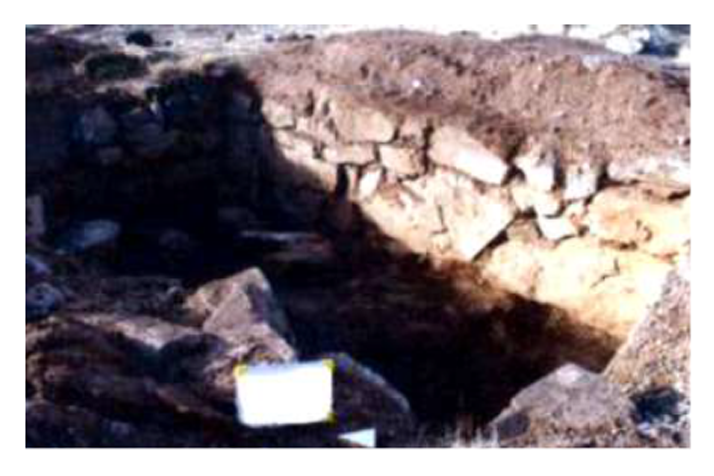
Along with predatory and destructive human behavior, nature also played a major role in destroying the Shereyeri. It is said that what we know today as Shaheryeri is only 20% of the entire complex. The Iranian government left this unique place to God's mercy for many years and did not take any steps to preserve it. However, after very serious protests, in 2002, Iran included this place in the list of national monuments! However, no serious work has been done to preserve this valuable historical place.
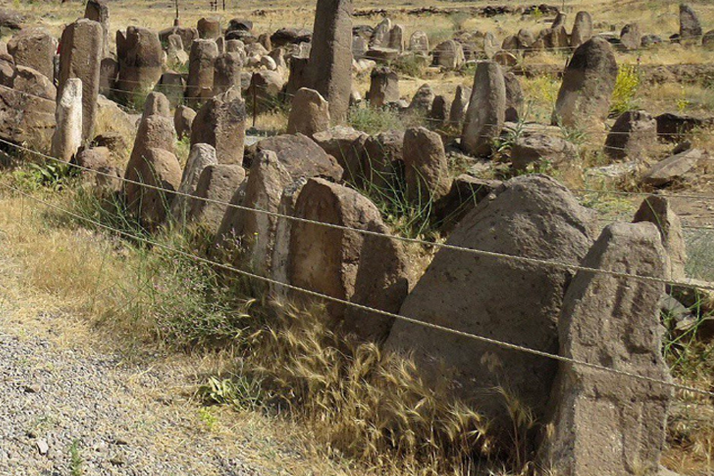
(Measures taken to preserve and protect valuable historical menhirs are visible in the picture (!)!)
In recent years, as a result of nearly 30 years of continuous activities of the activists of the South Azerbaijan National Movement and the public awareness about the importance of preserving and taking care of the material and moral heritage of Azerbaijan, we are witnessing an increase in people's appeals and even pressures to the state institutions regarding the Sheheryeri. These appeals and pressures have been implemented in various ways, including launching various campaigns, writing articles and reports in publications and news websites, and directly addressing state and local institutions and authorities. In fact, all these measures have three main goals:
Strengthening public awareness about the importance of cultural and historical heritage of Azerbaijan.
To inform the people of the Iranian government's deliberate disregard for the material and moral works of South Azerbaijan and to expose the anti-Turkish and anti-Azerbaijan nature of that government.
An attempt to compel the Iranian government to fulfill its obligations as a government to protect this valuable historical and cultural heritage.
It should be noted that protests against the Iranian government's and local authorities' disregard for the deplorable condition of the city are not limited to the above-mentioned activities, and people who are passionate about Azerbaijan have tried in every way to make their scream heard by the authorities and the world.
For example, on April 6, 2018, a group of South Azerbaijanis gathered in the borders of Shaheryeri, raised placards and demonstrated their protest against the Iranian government. Those who participated in the meeting condemned the neglect of the Iranian government, emphasizing the historical and spiritual value of the city, and demanded that necessary work be done to preserve these valuable monuments.
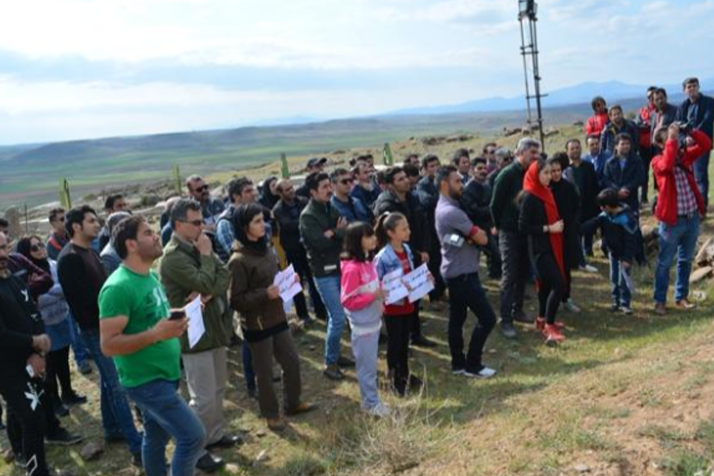
This move is considered a very important cultural move and even some Persian news sites at that time applauded those who took this initiative by sharing reports and information about it. Also, the posters in the hands of the participants were very important in terms of meaning:
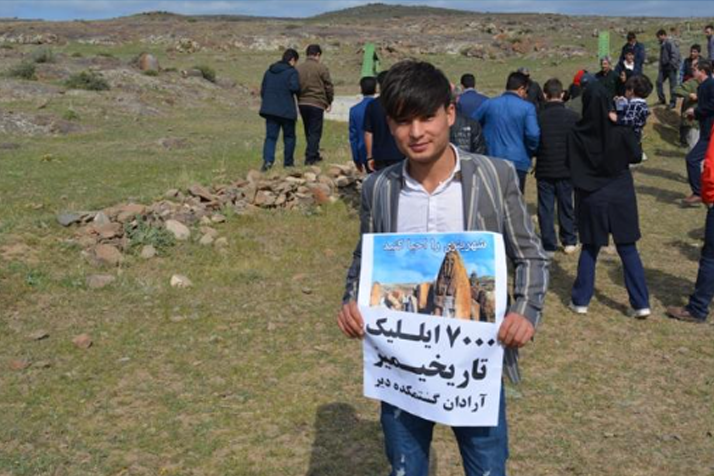
(Persian: Revitalize Sheheryer. Azerbaijani Turkish: Our 7,000-year history is disappearing)
By forming a human chain around the menhirs, the participants of the said meeting symbolically demonstrated that they will not allow the material and moral heritage of Azerbaijan to remain unprotected, and that they will protect them hand in hand if necessary.
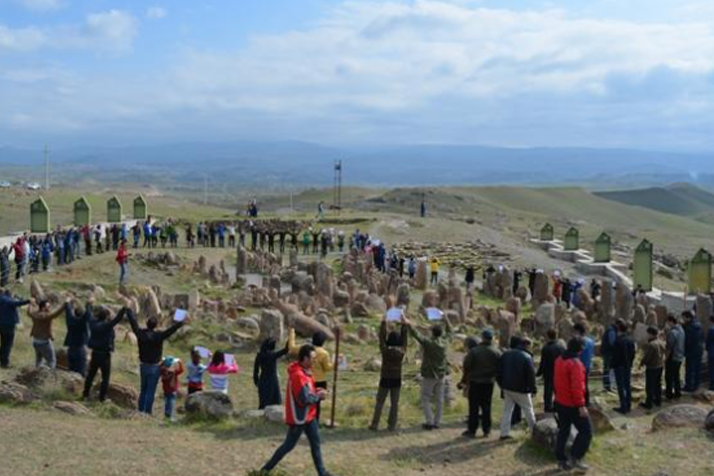
As a result of widespread protests by South Azerbaijani cultural figures and national activists, the local authorities were forced to state that this valuable collection is in a deplorable state and acknowledged the destruction and looting. Nevertheless, although it does not seem right to say that these protests are completely resultless, we still do not witness any serious steps being taken to protect this valuable and extensive historical complex.
Of course, it cannot be denied that some work has been done in this regard in recent years, even very little. But it seems impossible to achieve this big goal with these small steps. Local government officials say that serious measures will be taken in this regard with the intention of preventing the protests of the Turks of South Azerbaijan.
But at the same time, drawing attention to the financial resources required for this work, they admit that not enough funds are allocated by Tehran. Of course, the tone of local officials of South Azerbaijan criticizing Tehran is always conservative and cowardly. However, according to their cowardly words, Tehran refuses to allocate the necessary funds for the maintenance and protection of this complex.
This is not strange for the Turks of South Azerbaijan. They have been aware of this situation for years and know that the Iranian government, which receives a significant part of the state budget through South Azerbaijan (taxes, production, mines, labor...) is not ready to spend a small part of that budget on South Azerbaijan itself.


